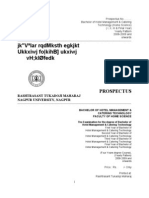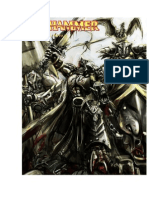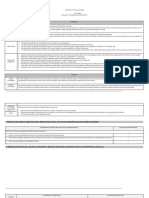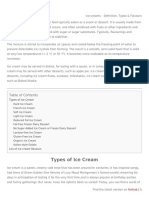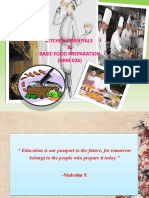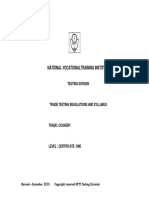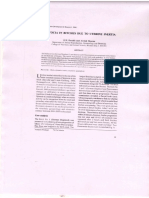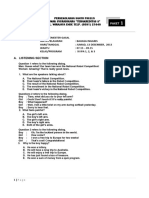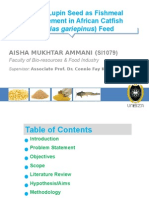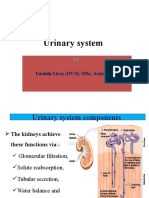Notes
Notes
Uploaded by
api-259636807Copyright:
Available Formats
Notes
Notes
Uploaded by
api-259636807Original Title
Copyright
Available Formats
Share this document
Did you find this document useful?
Is this content inappropriate?
Copyright:
Available Formats
Notes
Notes
Uploaded by
api-259636807Copyright:
Available Formats
PATES AND TERRINES
PATES
The term pate means forcemeat baked in a crust, usually in a rectangular or oval loaf
mold. In French it is termed as PATE EN CROUTE. In other words it can also be a
spread of finely chopped or pureed seasoned meat, often chicken liver.
In general sense the term pate applies to mixtures other than forcemeats baked in crust.
EQUIPMENT REQUIRED FOR MAKING PATE
Pate molds
The mold selected will determine the appearance of the final product. There are three
basic types of pate molds
1. Hinged oval pate molds are classical styled having ornate decorations on
the sides, is a distinctive feature of these molds. They come in a three
piece or a four piece hinged mold. The mold is sized by its mold capacity.
2. Hinged rectangular mold have contemporary styling. This allows a higher
product yield and easier portioning. Molds of this type have smooth or
textured sides but seldom decorative designs. Normally they are three
piece hinged molds. Those made from black steel are preferred as they
allow better browning
3. Tapered loaf pans give pate a home-like appearance. The sides of the mold
taper for easy removal
Pastry wheels
Scissors
Palette knives
Round cutters
Aluminum foil
PREPARATION
The preparation of pate is done in 5 stages
1. PRE-PREPARATION
Prepare the dough
Prepare the forcemeat
Roll the dough about 1/8th inch thick and about the size of the sheet pan
Using the assembled hinged mold, mark the dough for the main and the
cap pieces.
Allow for a inch overhang on all the sides.
The capping piece should be the size of the bottom
Cut 2 chimney rings from an extra piece of dough using 1 inch and inch
round cutter.
2. ASSEMBLING THE PATE
Lightly oil the assembled mold.
Fold the main piece of dough length wise. It should drop easily into the mold.
It should cover all the four walls and the bottom of the mold.
Using a small ball of scrap dough carefully press the dough into the corners of the
mold.
Cover and refrigerate the lined mold for one hour.
Fill the mold with well chilled forcemeat inch short of the top edge.
The forcemeat should be placed in several layers using a palette knife to press the
forcemeat to reduce the formation of the air pockets.
Fold the overhanging dough over the top of the forcemeat.
Lightly egg wash the dough covering the top.
Lightly eggs wash the face of the capping dough.
Lay the capping face, egg wash side down, on top of the pate.
3. INSERTING THE CHIMNEYS
Chimneys are placed in the pate to allow steam to escape. If chimneys are not
present the steam can crack the crust. The bottom and the four walls of the mold to be
covered with the dough.
4. COOKING THE PATE
Cooking the pate is divided into two stages-
Browning Stage without egg washing the top of the pate, cover the pate with a
foil. Place in a pre heated oven at 475 degrees F, for 10 minutes. Remove from
the oven and allow rest for 15 minutes.
Cooking Stage uncover and lightly egg wash the top of the pate. Place in a
preheated oven at 350 degrees F until an internal temperature is reached to 150
degrees F
NOTE: The temperature can be taken through the chimney
5. FINISHING THE PATE
The pate is not complete when it is removed from the oven. It must be first filled
with aspic.
Allow the pate to rest at room temperature for 15 minutes. This will allow the
juices and fat those have come out of the pate to be absorbed back.
Carefully fill the chimneys with a good quality aspic jelly.
Allow the pate to chill overnight before removal and slicing.
TERRINES
TERRINES are the closest cousin of pates.
The terrine vessel is an oblong, earthenware mold. It can also be enameled cast iron .
Terrines are the pate cooked in terrine mold and not a crust.
Terrines can also be made using pre-cooked paste of meat, fish or vegetable purees
bound cold with gelatin or hot with eggs.
Terrines can be served directly from the mold or removed.
They are most often served cold however they can also be served hot.
EQUIPMENT REQUIRED
Terrine molds
Plastic food film
Palette knife
Water bath with a rack
PREPARATION
The preparation can be divided into 4 stages.
1. PRE-PREPARATION- The first step is to select a suitable mold.
Lightly oil the mold
Line the mold with single piece of plastic film, large enough to cover
the bottom and the four sides.
Prepare the forcemeat.
2. ASSEMBLING THE TERRINE
Fill the terrine half with forcemeat, being careful not to form the air
pockets.
Place the garnishes if any.
Fill the terrine with the remaining forcemeat to the shoulder of the
mold.
Fold the overhanging plastic sheet over the forcemeat.
Place the lid on the terrine.
3. COOKING THE TERRINE-
Assemble the water bath
Place terrine in the water bath
Place in the pre heated oven at 325 degrees F
Cook to an internal temperature of 140 degrees F
Remove from the water bath
Cool at room temperature for 30 minutes.
4. PRESSING TERRINES-
A cooked terrine is pressed by removing the lid and placing a
metal plate, cut to fit the opening of the terrine, on top of the plate
and the terrine is refrigerated overnight
GALANTINES
Galantine is a boned poultry or game animal stuffed with forcemeat.
Modern galantines are more often rolled into an even, elongated shape resembling a
thick sausage.
The meat of the poultry or game may be left attached to the skin in its natural position.
Poultry or game may also be skinned first and the prime pieces, such as the breast,
used for the inlays
Once assembled, the galantine is poached and left to cool in a rich stock
The stock is made from the animal which has been used.
When cooled, galantines may be braised briefly
PREPARATION
The preparation of galantine is divided into three stages.
1. PRE-PREPARATION-
Begin with a chicken which has been plucked, dressed, washed and
singed.
Remove the wings at the second joint and reserve for the stock.
Skin the bird.
Remove the meat from the bones.
Marinate the breast meat and skin for 3 hours with brandy, white wine,
curing salt, salt and pepper.
Prepare the stock from the bones.
Prepare the forcemeat
2. ASSEMBLING THE GALANTINE
Assembling the galantines is simply a matter of placing and rolling.
Dampen a piece of cheesecloth. Fold in half and spread on the work
table.
Dust the skin lightly with a pinch of dry gelatin, salt and pepper.
Spread the forcemeat on the skin, one inch thick, leaving one inch
margin of skin all around.
Place the marinated breasts lengthwise, on the forcemeat with the
thinner ends of the breast, overlapping in the middle.
Using the cheesecloth, roll the galantine away from you
Make a snug roll free of any large wrinkles in the cheesecloth.
Gather the cheesecloth at one end of the roll and tie like a toffee.
Do the same with the other end also.
3. COOKING THE GALANTINE
Place the galantine in a big brazier.
Cover with the prepared stock and place on the range.
Bring the temperature of the stock up to 190 degrees F
Poach the galantine till the internal temperature reaches up to 170
degrees F
Refrigerate overnight in the same stock
4. PRESENTATION
Traditionally the galantines are sliced and served with small cubes
of delicate aspic.
ROULADES
The term roulade can be applied to contemporary products prepared in the manner
which is similar to galantine, yet do not satisfy the classical definition of the galantines.
They are generally made by boneless flank steaks, butter flied, pounded, spread and
then a filling of forcemeat or any other minces are added and is rolled in the style of the
galantine
The roulade is then either roasted or poached.
The variety of roulade is unlimited.
The roulades are sliced and served hot or cold.
BALLOTINES
This is the smaller relative of galantines
It is an excellent method for using the leg portion of poultry when the breasts have been
used in the other preparations
The legs are de-boned, leaving the meat and the skin intact.
Forcemeat or any other mince is stuffed into the pocket and then the pocket is carefully
sealed.
The ballotine is normally roasted or braised.
It can be glazed with aspic or coated with chaud-froid sauce and can be served cold or
hot.
PARFAITS
This is the French word for PERFECT
It refers to two distinctly different items.
1. One is a frozen mousse like dessert of lightened still frozen ice cream, which is
served in a tall glass.
2. Other parfait is a savory terrine which uses vegetables, fish, shell fish, poultry or
other light meats. It is distinguished by its very fine texture and preparation
methods.
It is based on raw mousseline forcemeat. Whipped cream is incorporated
into this mixture for lightness. This mixture is set with gelatin, not by heat.
The second method is based on a puree of cooked meat or vegetable
fortified with egg whites and is lightened with cream. The mixture is then
molded and poached.
A parfait can be cooked in a terrine mold, large timbale or loaf pan.
MOUSSE AND MOUSSELIN
These terms have two applications.-
MOUSSE The mixture is a cooked puree, bound with gelatin and lightened with
cream, is set by chilling.
MOUSSELINE FORCEMEAT Is composed of raw pureed meat or fish combined with
eggs and cream set by cooking
MOUSSE AND MOUSSELINE These terms also refer to the size of the finished dish.
A mousse, hot or cold, is a dish made of mousse mixture or mousseline forcemeat. It is
molded in a terrine, suitable to serve more than two people.
A mousseline is a small quenelle or molded individual portion of mousse mixture. Serve
cold.
Notes Compiled By: Tarak Sharma, IHTM, CSJMU, KANPUR
You might also like
- Brother Da I-B712 DB I-B760: Instruction ManualDocument16 pagesBrother Da I-B712 DB I-B760: Instruction Manualbrikki4450% (2)
- (AFL) Kitchen & Food Safety Case Study - : RatatouilleDocument3 pages(AFL) Kitchen & Food Safety Case Study - : RatatouilleLux LampsNo ratings yet
- Tracking Animal Migration With Stable IsotopesDocument269 pagesTracking Animal Migration With Stable IsotopesHugoBenitezdNo ratings yet
- Culinary Arts 1Document5 pagesCulinary Arts 1Azim Bin AmranNo ratings yet
- Hotel Management & Catering Technology SyllabusDocument81 pagesHotel Management & Catering Technology SyllabusYelesh LanjewarNo ratings yet
- Front Office and Guest Safety and SecurityDocument11 pagesFront Office and Guest Safety and SecurityCrisVaz75% (8)
- Warhammer Armies - DraconianDocument75 pagesWarhammer Armies - Draconiannikoladaba100% (7)
- Pate and TerrineDocument5 pagesPate and Terrinesweedld100% (1)
- Pate, Making of Pate PDFDocument3 pagesPate, Making of Pate PDFabhishek tagdeNo ratings yet
- History of HotelsDocument13 pagesHistory of HotelsR.l. Garcia0% (1)
- 1.1 Clean Sanitize and Prepare ToolsDocument22 pages1.1 Clean Sanitize and Prepare Toolssecret 22No ratings yet
- Gueridon Service StyleDocument33 pagesGueridon Service StyleMandeep Singh100% (1)
- Fundamentals in Foodservice OperationsDocument16 pagesFundamentals in Foodservice OperationsbfgenterolaNo ratings yet
- Methods of Cooking MeatDocument4 pagesMethods of Cooking MeatMark Russel MacapiliNo ratings yet
- Ice-Creams  - Definition, Types & FlavoursDocument6 pagesIce-Creams  - Definition, Types & FlavoursFarhan KaziNo ratings yet
- Syllabus (Asian Cuisine)Document17 pagesSyllabus (Asian Cuisine)marie100% (1)
- INTRODUCTION TO SPECIALITY CUISINE (Acruz)Document7 pagesINTRODUCTION TO SPECIALITY CUISINE (Acruz)Trisha Mae AcruzNo ratings yet
- Typical Italian Cuisine and Its CharacteristicsDocument13 pagesTypical Italian Cuisine and Its Characteristicsosvishnuinland100% (5)
- Overviewbartendingflairtending 190319152701Document37 pagesOverviewbartendingflairtending 190319152701Jess Aquino Jr.No ratings yet
- Culinary Terminology - Assigment 1Document2 pagesCulinary Terminology - Assigment 1Gary Roach100% (1)
- Chapter 1 6 Larder 1Document32 pagesChapter 1 6 Larder 1Nawed Khan100% (1)
- NCC Culinary SyllabusDocument8 pagesNCC Culinary SyllabusAndrew GordonNo ratings yet
- French CuisineDocument22 pagesFrench Cuisinesonam2411No ratings yet
- Terminologies CookeryDocument75 pagesTerminologies CookeryMonette ColomaNo ratings yet
- Gueridon Service Reference BookletDocument53 pagesGueridon Service Reference BookletManolo Solano100% (2)
- Cooking Starches: DescriptionDocument6 pagesCooking Starches: DescriptionLucille PaglingayenNo ratings yet
- Mise en PlaceDocument23 pagesMise en PlaceRaziel UlbenarioNo ratings yet
- Poultry: Members: Shaira Restauro Kenny Soposo Denise TyDocument73 pagesPoultry: Members: Shaira Restauro Kenny Soposo Denise TyDenise Antoinette TyNo ratings yet
- Hpc1 Chapter 1 The Organization of Modern KitchensDocument12 pagesHpc1 Chapter 1 The Organization of Modern KitchensMichaella CasinioNo ratings yet
- Terminologies in BakingDocument29 pagesTerminologies in BakingReggie Ann Perez67% (3)
- Larder and Larder ControlDocument7 pagesLarder and Larder ControlFarhan KaziNo ratings yet
- Bread and Pastry Production NC Ii Competency-Based Learning MaterialsDocument75 pagesBread and Pastry Production NC Ii Competency-Based Learning MaterialsNeyho Nolak AmamutNo ratings yet
- Plated DessertsDocument4 pagesPlated DessertsVener SalipotNo ratings yet
- Icai Comcok NC Iii MfabiDocument31 pagesIcai Comcok NC Iii MfabiMylina FabiNo ratings yet
- Recipes: SITHCCC012 Prepare Poultry DishesDocument23 pagesRecipes: SITHCCC012 Prepare Poultry DishesNina Jane QuinteroNo ratings yet
- Kitchen Equipment SelectionDocument21 pagesKitchen Equipment Selectioncucucucucu72No ratings yet
- Basic ConceptDocument20 pagesBasic ConceptGina BundaNo ratings yet
- Cook MeatsDocument102 pagesCook Meatswookie jiNo ratings yet
- Iscahm DCA-ACIII CourseDocument4 pagesIscahm DCA-ACIII CourseRotciv Reyes CumigadNo ratings yet
- Kinds of PastasDocument50 pagesKinds of PastasJenny BelarminoNo ratings yet
- Kitchen Essentials & Basic Food Preparation (HRM 026)Document50 pagesKitchen Essentials & Basic Food Preparation (HRM 026)Novel LampitocNo ratings yet
- Lesson 8Document18 pagesLesson 8Nika KatanoNo ratings yet
- Preparing DessertsDocument15 pagesPreparing DessertsAdeleine CantorneNo ratings yet
- An Introduction To Spanish CuisineDocument3 pagesAn Introduction To Spanish CuisinecpbelenNo ratings yet
- 326 33 Powerpoint-Slides 6-Meats PDFDocument65 pages326 33 Powerpoint-Slides 6-Meats PDFPavan PatelNo ratings yet
- Notes On Organise EntremetierDocument8 pagesNotes On Organise EntremetierEmir Ketchie100% (3)
- Food PlatingDocument6 pagesFood PlatingYvonne Angel MedranoNo ratings yet
- Basic Cooking: Preparation and Cooking FoodDocument6 pagesBasic Cooking: Preparation and Cooking Foodkevin mendozaNo ratings yet
- 2 Principles of Food ProductionDocument40 pages2 Principles of Food ProductionRubyann Faye Obero LendioNo ratings yet
- Preparemeat DishesDocument82 pagesPreparemeat Disheskarla villafloresNo ratings yet
- Part One Part TwoDocument62 pagesPart One Part TwoLeo Patrick CabrigasNo ratings yet
- Clean and Maintain Kitchen Premises - Cookery IiDocument14 pagesClean and Maintain Kitchen Premises - Cookery IiCarla Grace Tobias-Samoy RocNo ratings yet
- Quiz 3 - Introduction To Modern Food ServiceDocument41 pagesQuiz 3 - Introduction To Modern Food ServiceHany Dyanne Andica TeopeNo ratings yet
- Types of FishDocument46 pagesTypes of FishDelhindraNo ratings yet
- Core #5Document82 pagesCore #5Ma.Andrea GanacanNo ratings yet
- Bread and Pastry Productions Nc-IiDocument8 pagesBread and Pastry Productions Nc-IiSushi WasabiNo ratings yet
- Mother SaucesDocument8 pagesMother SaucesBarbarian KingNo ratings yet
- National Vocationaltraining Institute: Testing DivisionDocument64 pagesNational Vocationaltraining Institute: Testing DivisionAvoryi Juliana100% (1)
- Organise & Prepare Food Products and Services - PR - 24-12 - SPDocument7 pagesOrganise & Prepare Food Products and Services - PR - 24-12 - SPTiara Niken ANo ratings yet
- Waste into Taste: Turning Scraps into Delicious DishesFrom EverandWaste into Taste: Turning Scraps into Delicious DishesNo ratings yet
- Blog 3Document1 pageBlog 3api-259636807No ratings yet
- ChocolateDocument2 pagesChocolateapi-259636807No ratings yet
- FoodbevlessDocument21 pagesFoodbevlessapi-259636807No ratings yet
- Sea LifeDocument8 pagesSea Lifelaureblct23No ratings yet
- Full Blast PLUS 1 (Beginners) - Grammar Test - Mod 2Document2 pagesFull Blast PLUS 1 (Beginners) - Grammar Test - Mod 2Atlanticcca0% (1)
- 5B GMGDocument9 pages5B GMGknight.errantNo ratings yet
- TissuesDocument8 pagesTissuesJanak Priya pandNo ratings yet
- Icopim Vol 2Document169 pagesIcopim Vol 2DannKusumaNo ratings yet
- مذكرة شرح علوم الصف الرابع الابتدائي لغات 2015 science for primary 4 second term 2015 Prim 4secondTERM2015Document29 pagesمذكرة شرح علوم الصف الرابع الابتدائي لغات 2015 science for primary 4 second term 2015 Prim 4secondTERM2015rabei95% (55)
- Reli 73H Textbook IntroDocument17 pagesReli 73H Textbook IntroAnna ReeceNo ratings yet
- Mistake of Magic Book 2Document150 pagesMistake of Magic Book 2Aarushi100% (2)
- Word GamesCoolDocument94 pagesWord GamesCoolaszmagNo ratings yet
- Bản sao 001 - BDDT - 21-22 - OLDocument7 pagesBản sao 001 - BDDT - 21-22 - OLuyenNo ratings yet
- Uterine Inertia BitchDocument3 pagesUterine Inertia BitchgnpobsNo ratings yet
- Soal1 UTS Read3 TOEFL Oct23Document14 pagesSoal1 UTS Read3 TOEFL Oct23fried mhNo ratings yet
- Traction: Dr.K.Arvind Natarajan 1 Year MS OrthoDocument30 pagesTraction: Dr.K.Arvind Natarajan 1 Year MS OrthoKarthick50% (2)
- Cerebellum, Thalamus, and HypothalamusDocument40 pagesCerebellum, Thalamus, and Hypothalamusasep100% (1)
- AsanasDocument3 pagesAsanassreejitkaimalNo ratings yet
- Ujian Semester Gasal Kelas Xi IpaDocument38 pagesUjian Semester Gasal Kelas Xi IpaRichard sutantoNo ratings yet
- Food Safety Act of 2013Document12 pagesFood Safety Act of 2013Joshua Corcothea PacuancuanNo ratings yet
- Exercise 2 Excel Logical FunctionDocument264 pagesExercise 2 Excel Logical FunctionrhieelaaNo ratings yet
- Lupin Seed As Replacement For Fishmeal in African Catfish (Clarias Gariepienus) FeedDocument26 pagesLupin Seed As Replacement For Fishmeal in African Catfish (Clarias Gariepienus) FeedBashir Muzakkar100% (1)
- Exercise 4: Motor Control Systems: ABST-1L Group 2 Dimaculangan, Quintana, Reyes, Santos, VillaosDocument38 pagesExercise 4: Motor Control Systems: ABST-1L Group 2 Dimaculangan, Quintana, Reyes, Santos, VillaosofficialpatdeeNo ratings yet
- (English) Most Dangerous Animals You Should Never Touch (DownSub - Com)Document5 pages(English) Most Dangerous Animals You Should Never Touch (DownSub - Com)Afifah NurNo ratings yet
- Tea PartyDocument3 pagesTea PartySaraA.DelgadoNo ratings yet
- Urinary System: Tsedalu Yirsa (DVM, MSC, Assist Prof.)Document18 pagesUrinary System: Tsedalu Yirsa (DVM, MSC, Assist Prof.)Mohammed OumerNo ratings yet
- Bush PigDocument2 pagesBush Piglengyianchua206100% (1)
- Gramatica EnglezaDocument36 pagesGramatica EnglezaMiruna BanicaNo ratings yet
- 10 PurposeDocument2 pages10 PurposeCosmina SăndicăNo ratings yet




